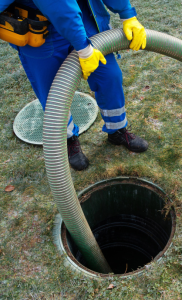A septic tank holds household wastes until bacteria in the leach field break them down. The tank is usually precast from reinforced concrete and buried in the ground.

Wastewater from toilets and sinks enters the septic tank where solids settle to the bottom as the sludge layer. The lighter grease and soap floats to the top as the scum layer. Visit https://septic-guys.com/ to learn more.
All the water and waste that comes out of your home through toilets, sinks, showers, garbage disposals, and washing machines goes into a septic tank. The septic system, which is a form of on-site wastewater treatment (OWT), removes solids from the wastewater and disperses it into soil. The soil’s natural processes treat and dispose of the wastewater, which prevents it from entering groundwater. This process is vital for reducing the amount of germs and chemical pollutants in the environment.
The septic tank has a wall that separates the inlet and outlet chambers. The inlet chamber retains the heavier, more dense solids such as toilet paper, feces, food scraps, and grease that are too large to pass through the outlet filter. The septic tank also has an exit valve that opens when the solids in the septic tank have settled to the bottom, and the sludge layer is ready to be removed.
After the septic tank settles the solids, the microorganisms in the septic tank break down these solids. The resulting liquid effluent is called primary effluent. The septic tank also contains a floating layer of lighter, smaller solids. This scum layer is made of fat, oil, and grease that comes from kitchens, and other domestic activities. This scum must be skimmed off periodically. This scum layer may dry out and harden, preventing air from reaching the bacteria inside. This is a sign that your tank needs desludging.
In order to function properly, the septic tank must be pumped regularly. This keeps the sludge layer from getting too thick, which can allow the solids to flow out of the septic tank into the drain field. When this happens, the solids clog pipes that carry wastewater to and from the septic tank and into the leach field. The clogged pipes prevent the septic system from working, and wastewater backs up into the house.
The septic tank’s baffles and effluent filters keep the sludge and scum from flowing out of the tank into the drain field. However, if the septic tank is not pumped regularly, these solids will flow out of the septic tank into a drainfield and wash into the soil. Over time, this waste will build up into an intensive biomat that clogs the soil pores and stops the flow of wastewater.
Septic Tank Filters
All of the water and waste from a household, from toilets to garbage disposals to washing machines, travels to a septic tank. Once there, anaerobic bacteria begin to break down organic material. Over time, the solids sink to the bottom of the tank, and liquids float to the top. This creates two distinct layers: a layer of scum made from oils and fats, and a layer of sludge composed of the heavier waste particles. A septic system also includes a pipe that runs from the septic tank to a leach field, where wastewater is absorbed into the soil.
A septic tank filter, often called an effluent filter, is installed on the outlet baffle of the septic tank to help prevent the scum mat and solids from entering the drain field and leach field. The filter is designed to be a low-cost option for homeowners, with the ability to reduce maintenance costs and improve the longevity of a septic system.
The filter is a cylindrical device that can be inserted on the outlet baffle line of an existing septic tank. It requires no electricity and very little maintenance to function effectively. Its effectiveness depends on the size of household, with larger households needing more robust filters than smaller ones.
As septic tanks fill, they release gases and odors. The most common is hydrogen sulfide, which smells like rotten eggs. To control the odor, a vented gas line connects from the septic tank to the home plumbing, and a charcoal filter is commonly placed in this line to minimize odors.
If a septic tank filter is clogged, sewage will back up into the household plumbing. Luckily, septic tank filters are easy to install, as long as the septic tank is designed with them in mind. One-compartment septic tanks do not typically include an effluent filter, while two-compartment septic tanks that were installed after 1996 generally do have them.
To avoid a septic tank filter from getting clogged, it is important to minimize the use of cleaning products and chemical solvents in the household. These chemicals kill bacteria and can cause the septic tank to fail by stopping the sludge separation process. In addition, cigarette butts and other foreign materials can build up in the area of the septic tank filter, preventing proper drainage of wastewater.
Septic Tank Pumping
Septic tank pumping is one of the most important aspects of a septic system’s maintenance. Without regular septic tank pumping, solid waste can overflow into the drain field and clog the septic system’s absorption pipes. This waste will not be properly broken down, which can lead to costly and dangerous sewage backups and environmental contamination. A septic tank’s inlet and outlet tees must also be inspected for blockages and damage to the baffles.
A septic tank contains bacteria that break down the organic waste in wastewater. However, if this bacteria is killed off by bleach, drain cleaner or other household chemicals, a layer of solid waste will build up inside the septic tank. This will prevent the bacteria from breaking down the remaining waste, which can overflow into the septic system’s leach field and cause sewage to back up into homes and drains.
Regular septic tank pumping removes the sludge layer that accumulates over time, which keeps the septic tank from overflowing and helps protect the septic system’s drain field and septic system components. The sludge layer is composed of a thick, dark material that must be removed by professional septic tank pumpers to ensure the septic system works properly.
There are many variables that determine how often a septic tank needs to be pumped, including the size of the tank, household size and what type of household waste is generated. Some households need their septic tanks pumped more often than others, because they produce a greater volume of waste. This is due to a larger household, a septic tank with a smaller capacity and other factors such as using a garbage disposal or running a home business.
Septic tank pumping is usually performed by a licensed liquid waste hauler who will access the septic tank by removing its lid. Once the septic tank is pumped, the hauler will transport the septic tank waste to an approved waste treatment and disposal facility. It is not recommended that homeowners attempt to pump their septic tanks themselves because of the health and safety risks involved.
Septic Tank Installation
Septic tanks are large underground containers that receive wastewater from all the toilets, showers and sinks in a home. When the tank fills up, solid waste (called sludge) settles at the bottom and oily substances rise to the top. Bacteria inside the septic tank break down the remaining waste. The liquid waste (called effluent) then flows out of the tank into a drain field, where it is further treated and absorbed by the soil.
During the installation process, a professional will connect the septic tank inlet pipe to the house plumbing and the outlet pipe to the drain field. The tank will be buried to a depth that allows for gravity flow from the house basement drains. The tank will also be designed to withstand the weight of 2 to 3 feet of soil over it. This allows future residential renovations and landscaping projects to be completed without fear of impacting the septic tank.
If a septic tank is installed in an area that has vehicular traffic, it may be necessary to install a concrete cover. This can be done to reduce the risk of damage or injury due to a vehicle accident or a child running into the tank. It can also be used to prevent erosion or surface water inflow into the tank or drain field.
The inlet baffle to the septic tank should be checked regularly for clogs. This can be done by inserting a pole into the inlet opening and using it to pull out any objects that are stuck. If the clog is too severe, it is recommended to contact a service professional.
Once the septic tank is fully installed, it should be tested and approved by local health and environmental officials. Once this is done, homeowners can enjoy the benefits of a septic system that eliminates the need for expensive and polluting municipal sewage systems.
Septic tank installation is a complex job that requires the help of trained professionals to ensure it is completed properly. The tank, inlet and outlet pipes, distribution box and pump will need to be correctly connected to ensure the proper treatment of sewage waste. Regularly scheduled septic tank pumping and inspections are essential to maintaining the efficiency of the system and preventing costly repairs.








